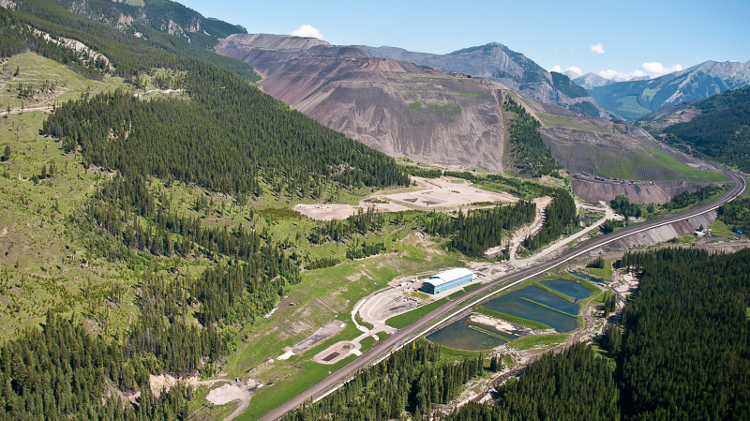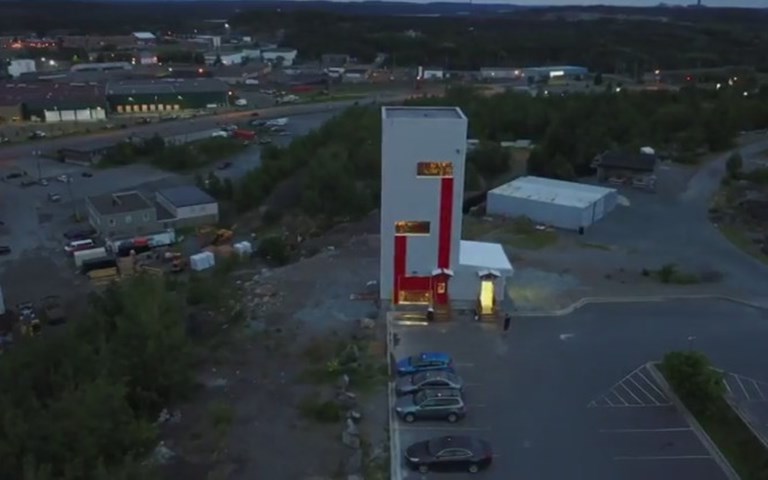UDMN’s hydraulic air compressor demonstrator is installed in what was an elevator shaft, and will act as a testing facility and a template for the commercial production of similar systems at mines around the globe. Courtesy of Electrale Innovation.
Finding new ways to use old tools is the cornerstone of innovation, and Ultra-Deep Mining Network’s (UDMN) Hydraulic Air Compressor (HAC) demonstrator, officially unveiled today at Science North’s Dynamic Earth in Sudbury, Ontario, is the product of just such a process.
The HAC demonstrator, installed in what was an elevator shaft, will act as a testing facility and a template for the commercial production of similar systems at mines around the globe. The goal of the project is to produce compressed air for pneumatic power with less energy and lower costs. Dean Millar, MIRARCO’s director of energy, renewables and carbon management who conceptualized the innovations for the HAC and led the team that developed it, told CIM Magazine that this system will consume at least 13 per cent less electricity than mechanical compressors.
Dean Millar explains his energy reduction strategy for underground mines
The HAC relies on water and gravity to compress air rather than an electrically powered engine and is constructed with no moving parts other than the two centrifugal pumps, so the system is relatively maintenance free. “Historically, the majority of the HACs that were built in mines outlived the resources; it’s a very, very reliable technology,” explained Millar.
The first HAC and one of Millar’s inspirations for this project, Ragged Chutes in Cobalt, Ontario, was built in 1910 and worked nearly continuously for almost 70 years.
Millar said he believes that because his system uses less electricity and has low maintenance costs, HACs will be able to reduce the lifecycle cost of compressed air in mines by 40 per cent. “It can be better than that if you take advantage of site-specific resources that might be present, as mines typically already have shafts and raises that can be reengineered for use in HACs, in which case development costs are even lower.”
How it works
Water from the forebay chamber and air from the atmosphere descend the 100-feet downcomer shaft together, and as they travel downwards, the water compresses the bubbles of air. At the bottom of the shaft the gas and liquid are separated in the air-water separation chamber. At this point, the compressed air travels in a tube to its destination while the pumps raise the water up the riser shaft to be used again in the closed circuit.
UBC engineering professor Ali G. Madiseh has a plan to help miners stop burning money
This straightforward system not only compresses air, it simultaneously cools the gas without needing additional equipment, as mechanical compressors do.
With ore grades declining, many mining companies are digging deeper to access minerals, but the deeper you dig, the hotter the mine will be. Millar said he anticipates that the compressed air released from an HAC will be approximately -60 C. This stream can be mixed with the ventilation air to bring down the aggregate temperature of the mine, allowing operations to mine deeper by maintaining a comfortable temperature for the workers underground.
What has been holding HACs back?
Former HACs used natural sources of flowing water instead of a cyclical system, and because pneumatic power cannot travel more than a few kilometres efficiently, the location of the resources had to correspond to the location of the demand, which was not always feasible. This newest version of the HAC makes use of a continuous loop system so that it can be set up in any environment regardless of the resources available.
Additionally, older models of HACs sometimes produced oxygen-deficient gas due to the solubility of gases in water at high pressures. The farther down water and air travel together in the shaft, the greater the pressure on the gas is. When there was too much pressure, the oxygen dissolved in the water, which allowed it to bypass the air-water separator, thereby reducing the amount of oxygen being produced. Millar has come up with the solution of adding salt to the water, which will dissolve first and so prevent oxygen from dissolving.
With these issues resolved, Millar is confident that HACs will prove to be an energy- and cost-efficient system.
How miners are mitigating energy inefficiency
UDMN collaborated with MIRARCO Mining Innovation, Laurentian University, Electrale Innovation, Reasbeck Construction, Centre of Excellence for Mining Innovation, Cambrian College, Vale, Northern Ontario Heritage Fund Corporation and Independent Electricity System Operator to fund and build the project.
Millar said he is already in talks with mining companies both in Canada and internationally about setting up HACs at their sites.




